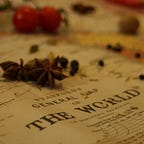Before the Tomato Arrived in Italy
Italian cuisine without tomatoes? Unthinkable! Many of the world’s most loved Italian recipes rely on tomatoes in one form or another. Think Pizza, Bolognese, Bruschetta, Caprese. However, the tomato only came to the Old Continent after the European conquests in the Americas, some time after 1492.
What did Italian cuisine look like before the sixteenth century?
The tomato is not the only plant that came from the American continent. There were no potatoes, no peppers, no maize, no chocolate — all foods the conquistadores brought back from their voyages to the New World. Not even the vegetable with the most Italian name of all: the zucchini, also known as courgette.
A 15th century Florentine food market would have featured absolute classics such as onion, garlic, chicory, carrot, and parsnip. In some cases, the crop’s name gives away that Italians were familiar with them before they made their ways into vegetable gardens further North and nobody bothered to invent a local term for them: broccoli or perhaps the yet more telling romanesco broccoli and the equally evident cavolo nero. It seems that cauliflower was known to the chefs labouring in the kitchen of the Medici, while the peasantry relied on staples like lentils and broad beans. A relatively novel introduction into the vegetable garden may have been the aubergine, making it’s way to Italy from Spain. Also, new arrival in Renaissance Italy: the artichoke.
The northern Italian republics of Venice and Genoa were connected to a spice trading network from the Middle East. Medieval spices would have included pepper, nutmeg, saffron, ginger, cloves, cardamom, cinnamon, caraway, and cumin. The Italians had a monopoly on the spice trade which made pepper immensely valuable and it’s well known that it was used as a currency. Therefore extravagant spices were reserved for the aristocracy.
Perhaps certain herbs and locally available spices, such as anise, fennel, fenugreek, sage, thyme, parsley, and coriander, would have made the meals of the 99% a bit more delightful.
While this may present an abundance of choices, indulging in fresh produce, various dairy products, and fresh meat was mostly reserved to the wealthy and powerful. Normal people probably had a pretty bland diet with whatever was available, cheap or preservable.
One thing to remember is that most foods would have been different, albeit related, to our modern day crops. Certain plants, especially the ones from the nightshade family, were known to be poisonous or contain poisonous parts, such as their flowers, seeds or roots. Non-poisonous varieties had to be bred and cultivated first whilst the genetics of breeding were yet not well understood. All fruit and vegetable was cooked. Not only to make it easier to digest, but also because people thought raw produce harboured diseases.
Medieval cookbooks
What ended up on the table hundreds of years ago may be a historic afterthought since these folks managed to get by without sharing their meals on Instagram. Luckily, we know about their diets because there is a reasonable amount of evidence from the period. Johannes Bockenheimer claimed to have been the cook of Pope Martin V and he wrote a cookbook around 1435. Note that this is before printing was widespread and we are talking about hand-written manuscripts here. Some of them are preserved until today and can be found in collections in Paris and Lugano. Going further back to the 13th century, we can derive some of the ingredients for a medieval Italian banquet from an inventory of available fruits and vegetables in Milan (De magnalibus urbis Mediolani) that was written up in 1288.
Florentine finger food?
While tomatoes were absent, the other classic of Italian cuisine, pasta, would have been available as wheat was a wide-spread crop in the Middle Ages. Not our modern industrialised form of wheat, but rather a variety similar to some of the heirloom varieties that are available to this day, such as emmer wheat, or farro as it is known in Italy. Who knows what sauce they served with the pasta?
During the Renaissance, the culinary avant-garde was located in Florence and it is very likely that, along with elaborate pasta recipes, Catherine de Medici brought fine dining from Florence to France in the mid 16th century. She also brought a change in table manners to the French court by popularising the fork. Turns out most food in medieval Europe was fingerfood!
The splendour of the Medici’s cooking was largely based on condiments from the Far East. After the Byzantine empire had fallen and Constantinople came under Ottoman influence, it was much more difficult and costly to obtain the desired spices. In response, the Portuguese started exploring naval trading routes. It is an ironic historical quirk that the Genoa-born Cristopher Columbus, in his quest of an alternative route to keep the flow of pepper abundant, landed in the Americas and opened the door for the tomato’s conquest of Italian recipes.
To find out how this can inspire you to go on a culinary adventure, look no further.
